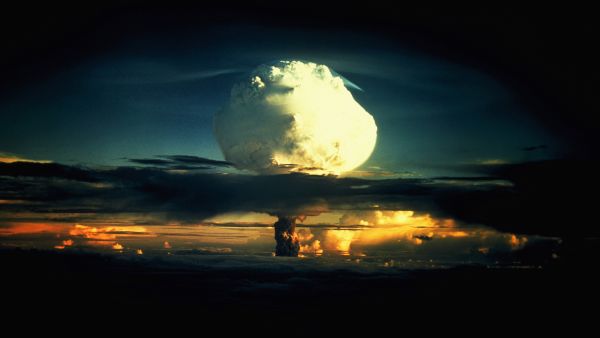
A U.S. Air Force base in Texas has taken the first steps to guard against an electromagnetic pulse (EMP) attack. But what, exactly, is an EMP, and how big is the threat?
Officials at the Joint Base San Antonio in Lackland, Texas, issued a request for bids to carry out a survey of a facility called the Petroleum, Oil and Lubrication Complex. The survey will identify any equipment that could be vulnerable to an EMP ahead of more detailed vulnerability testing, according to the request. After that, officials would figure out ways to keep that equipment safe in the event of an EMP attack.
Related: The 22 weirdest military weapons
What is an EMP?
An EMP is a massive burst of electromagnetic energy that can occur naturally or be generated deliberately using nuclear weapons. While many experts don't think EMPs pose a big threat, some people argue that these types of weapons could be used to cause widespread disruption to electricity-dependent societies.
"You can use a single weapon to collapse the entire North American power grid," said defense analyst Peter Pry, who served on the Congressional EMP Commission, which was set up to assess the threat of EMP attacks but shut down in 2017.
"Once the electric grid goes down, everything would collapse," Pry told Live Science. "Everything depends on electricity: telecommunications, transportation, even water."
According to the request, the testing at Lackland comes in response to a 2019 executive order issued by then-President Donald Trump for the federal government to strengthen its infrastructure against EMPs. Pry, who has consulted on the project, said the survey and resulting upgrades are part of a broader initiative by the U.S. Air Force to beef up its defenses against this type of threat.
Breaking space news, the latest updates on rocket launches, skywatching events and more!
Why EMPs are so dangerous
An EMP releases huge waves of electromagnetic energy, which can act like a giant moving magnet. Such a changing magnetic field can cause electrons in a nearby wire to move, thereby inducing a current. With such a huge burst of energy, an EMP can cause damaging power surges in any electronics within range.
Related: Doomsdays: Top 9 real ways the world could end
These pulses can occur deliberately or naturally. Natural EMPs occur when the sun occasionally spits out massive streams of plasma, and if they come our way, Earth's natural magnetic field can deflect them. But when the sun spits out enough plasma at once, the impact can cause the magnetic field to wobble and generate a powerful EMP. The last time this happened was in 1859 in the so-called Carrington Event, and while electronics were still rare then, it knocked out much of the recently built telegraph network.
Then, there's the possibility of deliberate EMPs. If a nuclear weapon were to be detonated high in the atmosphere, Pry said, the gamma radiation it would release could strip electrons from air molecules and accelerate them at close to the speed of light. These charge-carrying electrons would be corralled by Earth's magnetic field, and as they zipped around, they would generate a powerful, fluctuating electric current, which, in turn, would generate a massive EMP. The explosion could also distort Earth's magnetic field, causing a slower pulse similar to a naturally occuring EMP.
Setting off a nuclear weapon about 200 miles (300 kilometers) above the U.S. could create an EMP that would cover most of North America, Pry said. The explosion and radiation from the bomb would dissipate before reaching ground level, but the resulting EMP would be powerful enough to destroy electronics across the region, Pry said. "If you were standing on the ground directly beneath the detonation, you wouldn't even hear it go off," Pry said. "The EMP would pass harmlessly through your body."
A small EMP with a radius of under a kilometer can also be generated by combining high-voltage power sources with antennas that release this energy as electromagnetic waves. The U.S. military has a prototype cruise missile carrying an EMP generator. Called the Counter-Electronics High Power Microwave Advanced Missile Project (CHAMP), it can be used to target specific enemy facilities, and Pry said it would be within the capabilities of many militaries, or even terrorist groups, to build an EMP generator.
"We've arrived at a place where a single individual can topple the technological pillars of civilization for a major metropolitan area all by himself armed with some device like this," he said.
The technology required to protect against EMPs is similar to what is already used to prevent damage from power surges caused by lightning, Pry said. These technologies would have to be adapted to deal with higher voltages, but devices such as surge protectors, which divert excess voltage into the Earth, or Faraday cages, which shield devices from electromagnetic radiation, could do the job.
Pry said the EMP Commission estimated it would cost $2 billion to $4 billion to protect the most important pieces of equipment in the national grid, but ideally, he would like to see standards changed so that EMP protection is built into devices.
EMP: Should you worry?
The threat posed by EMPs is far from settled, though. A 2019 report by the Electric Power Research Institute, which is funded by utility companies, found that such an attack would probably cause regional blackouts but not a nationwide grid failure and that recovery times would be similar to those of other large-scale outages.
Frank Cilluffo, director of Auburn University's McCrary Institute for Cyber and Critical Infrastructure Security, said that, while an EMP attack would certainly be devastating, it's unlikely that the United States' enemies would carry out such a brazen assault.
"There are other ways that adversaries can achieve some of the same outcomes, some of which would be cheaper and some of which would be less discernible," Cilluffo told Live Science.
Such alternatives might include cyberattacks to take out critical infrastructure, including the electric grid, or even efforts to disrupt space-based communications or the GPS system that modern society is so reliant on. Work to protect against EMPs makes sense, particularly given the possibility of another Carrington-like event, but these upgrades shouldn't distract from efforts to shore up defenses against more probable lines of attack, Cilluffo said.
Original article on Live Science.
Join our Space Forums to keep talking space on the latest missions, night sky and more! And if you have a news tip, correction or comment, let us know at: community@space.com.

Edd Gent is a British freelance science and technology writer. He has a Bachelor of Arts degree in Politics and International Relations and is also an NCTJ qualified senior reporter. Edd's main areas of interest are engineering, computing, and biology. You can find more of his writing in places such as Live Science, IEEE Spectrum, and New Scientist, among others.

